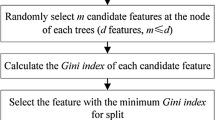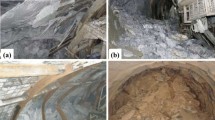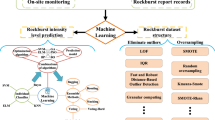Abstract
Rockburst prediction is the basis of rockburst prevention and construction guidance. However, the complexity of the rock burst occurrence mechanism and inducing factors and the suddenness and randomness of rock burst behavior make the accurate prediction of rock bursts very difficult. In this study, the eXtreme Gradient Boosting (XGBoost) algorithm is used to learn and predict the rockburst intensity of a database including 341 rockburst cases worldwide. A procedure for parameter optimization of XGBoost combined with grid search and cross validation methods is proposed. It improves the prediction performance, effectively avoids overfitting and also improves the operation efficiency. The model predicted 7 typical rockburst cases that occurred at **** II Hydropower Station, and the results showed that the GC-XGBoost model performs well in predicting rockburst intensity. In addition, compared with typical supervised learning models (SVM and RF), the model showed improved prediction performance. SHapley Additive exPlanations (SHAP, a game theoretic approach) was used to study the importance of feature parameters. The SHAP values showed that Wet and \(\sigma_{{\uptheta }}\) are the two most important feature parameters for predicting rockburst intensity.













Similar content being viewed by others
Data availability
All data and materials used during the study appear in the submitted article and supplementary information.
References
Adoko AC, Gokceoglu C, Wu L, Zuo QJ (2013) Knowledge-based and data-driven fuzzy modeling for rockburst prediction. Int J Rock Mech Min 61:86–95
Afraei S, Shahriar K, Madani SH (2019) Develo** intelligent classification models for rock burst prediction after recognizing significant predictor variables, Section 1 Literature review and data preprocessing procedure. Tunn Undergr Sp Tech 83:324–353
Baltz R, Hucke A (2008) Rockburst prevention in the German coal industry. In: Proceedings of the 27th international conference on ground control in mining. Morgantown, pp 46–50
Blake W, Hedley DGF (2003) Rockbursts: case studies from North American hard-rock mines. SME
Brown ET, Hoek E (1980) Underground excavations in rock. CRC Press
Cai M (2016) Prediction and prevention of rockburst in metal mines–a case study of Sanshandao gold mine. J Rock Mech Geotech 8(2):204–211
Chen TQ, Guestrin C (2016) Xgboost: a scalable tree boosting system. In: Proceedings of the 22nd acm sigkdd international conference on knowledge discovery and data mining, pp 785–794
Chen DF, Feng XT, Yang CX, Chen BR, Qiu SL, Xu DP (2013) Neural network estimation of rockburst damage severity based on engineering cases. In: Proc., Sinorock2013 Symp. London, pp 457–463
Dietterich TG (2000) Ensemble methods in machine learning. In: International workshop on multiple classifier systems, pp 1–15. https://doi.org/10.1007/3-540-45014-9_1
Dou LM, Chen TJ, Gong SY, He H, Zhang SB (2012) Rockburst hazard determination by using computed tomography technology in deep workface. Saf Sci 50:736–740
Du ZJ, Xu MG, Liu ZP, Wu X (2006) Laboratory integrated evaluation method for engineering wall rock rock-burst. Gold 27(11):26–30
Faradonbeh RS, Taheri A, e Sousa LR, Karakus M (2020) Rockburst assessment in deep geotechnical conditions using true-triaxial tests and data-driven approaches. Int J Rock Mech Mining Sci. 128:104279
Feng XT, Chen BR, Zhang CQ, Li XJ, Wu SY (2013) Mechanism, warning and dynamic control of rock burst development process. Science Press, Bei**g
Ghasemi E, Gholizadeh H, Adoko AC (2020) Evaluation of rockburst occurrence and intensity in underground structures using decision tree approach. Eng Comput 36:213–225. https://doi.org/10.1007/s00366-018-00695-9
Guo DP, Chen HM, Tang LB, Chen ZX, Samui P (2022) Assessment of rockburst risk using multivariate adaptive regression splines and deep forest model. Acta Geotech 17(4):1183–1205
Hucka V, Das B (1974) Brittleness determination of rocks by different methods. Int J Rock Mech Min Sci Geomech Abstr 11(10):389–392
Iannacchione AT, Zelanko JC (1995) Occurrence and remediation of coal mine bumps: a historical review. Proceedings: mechanics and mitigation of violent failure in coal and Hard-rock mines. Washington, DC, U.S
Ji B, **e F, Wang XP, He SQ, Song DZ (2020) Investigate contribution of multi-microseismic data to rockburst risk prediction using support vector machine with genetic algorithm. IEEE Access 8:58817–58828
Jia QJ, Wu L, Li B, Chen CH, Peng YX (2019) The comprehensive prediction model of Rockburst tendency in tunnel based on optimized unascertained measure theory. Geotech Geol Eng 37:3399–3411. https://doi.org/10.1007/s10706-019-00854-9
Kidybinski A (1981) Bursting liability indices of coal. Int J Rock Mech Min Sci Geomech Abstr 18(4):295–304
Kuhn M, Johnson K (2013) Applied predictive modeling. Springer, New York
Li N, Jimenez R (2018) A logistic regression classifier for long-term probabilistic prediction of rock burst hazard. Nat Hazards 90:197–215
Li N, Jimenez R, Feng XD (2017a) The influence of bayesian networks structure on rock burst hazard prediction with incomplete data. Proc Eng 191:206–214
Li TZ, Li YX, Yang XL (2017b) Rock burst prediction based on genetic algorithms and extreme learning machine. J Cent South Univ 24(9):2105–2113
Li DY, Liu ZD, **ao P, Zhou J, Armaghani DJ (2022) Intelligent rockburst prediction model with sample category balance using feedforward neural network and Bayesian optimization. Undergr Space 7(5):833–846
Li ML, Li KG, Qin QC (2023) A rockburst prediction model based on extreme learning machine with improved Harris Hawks optimization and its application. Tunn Undergr Sp Tech 134:104978
Liang W, Zhao G, Wang X, Zhao J, Ma C (2019) Assessing the rockburst risk for deep shafts via distance-based multi-criteria decision making approaches with hesitant fuzzy information. Eng Geol 260:105211
Liu R, Ye YC, Hu NY, Chen H, Wang XH (2018) Classified prediction model of rockburst using rough sets-normal cloud. Neural Comput Appl 31:8185–8193
Liu QS, Xue YG, Li GK, Qiu DH, Zhang WM, Guo ZZ, Li ZQ (2023) Application of KM-SMOTE for rockburst intelligent prediction[J]. Tunn Undergr Sp Tech 138:105180
Lundberg SM, Lee SI (2017) Consistent feature attribution for tree ensembles. Article Google Scholar
Ma K, Shen QQ, Sun XY, Ma TH, Hu J, Tang CA (2023) Rockburst prediction model using machine learning based on microseismic parameters of Qinling water conveyance tunnel. J Cent South Univ 30(1):289–305
Martin C, Kaiser P, McCreath D (1999) Hoek-Brown parameters for predicting the depth of brittle failure around tunnels. Can Geotech J 36(1):136–151
Papadopoulos D, Benardos A (2021) Enhancing machine learning algorithms to assess rock burst phenomena. Geotech Geol Eng 39:5787–5809. https://doi.org/10.1007/s10706-021-01867-z
Papadopoulos D, Benardos A (2023) Combining machine learning and numerical modelling for Rockburst prediction. Geomech Geoengin. https://doi.org/10.1080/17486025.2023.2207546
Potvin Y, Hudyma M, Jewell RJ (2000) Rockburst and seismic activity in underground Australian mines-an introduction to a new research project. In: ISRM International Symposium
Pu Y, Apel DB, Pourrahimian Y, Chen J (2019) Evaluation of rockburst potential in kimberlite using fruit fly optimization algorithm and generalized regression neural networks. Arch Min Sci 64(2):279–296
Rastegarmanesh A, Moosavi M, Kalhor A (2021) A data-driven fuzzy model for prediction of rockburst. Georisk 15(2):152–164
Roohollah SF, Abbas T (2019) Long-term prediction of rockburst hazard in deep underground openings using three robust data mining techniques. Eng Comput 35(2):659–675. https://doi.org/10.1007/s00366-018-0624-4
Russenes BF (1974) Analysis of rock spalling for tunnels in steep valley sides. Norwegian Institute of Technology
Shapley LS (1953) A value for n-persons games. Ann Math Stud 28:307–318
Shi XZ, Zhou J, Dong L, Hu HY, Wang HY, Chen SR (2010) Application of unascertained measurement model to prediction of classification of rockburst intensity. Chin J Rock Mech Eng 29(1):2720–2726
Shukla R, Khandelwal M, Kankar PK (2021) Prediction and assessment of rock burst using various meta-heuristic approaches. Mining Metall Explor 38(3):1375–1381
Singh SP (1987) The influence of rock properties on the occurrence and control of rockbursts. Min Sci Technol 5:11–18
Sun YT, Li GC, Yang S (2021a) Rockburst interpretation by a data-driven approach: a comparative study. Math Basel 9(22):2965
Sun YT, Li GC, Zhang JF, Huang JD (2021b) Rockburst intensity evaluation by a novel systematic and evolved approach: machine learning booster and application. B Eng Geol Environ 80(11):8385–8395
Thai DK, Tu TM, Bui TQ, Bui TT (2021) Gradient tree boosting machine learning on predicting the failure modes of the RC panels under impact loads. Eng Comput 37(1):597–608
Wang JA, Park HD (2001) Comprehensive prediction of rockburst based on analysis of strain energy in rocks. Tunn Undergr Sp Tech 16(1):49–57
Wang M, Zhu ZM, Liu JH (2012) The photoelastic analysis of stress intensity factor for cracks around a tunnel. Appl Mech Mater 142:197–200
Wang XT, Li SC, Xu ZH, Xue YG, Hu J, Li ZQ, Zhang B (2019) An interval fuzzy comprehensive assessment method for rock burst in underground caverns and its engineering application. Bull Eng Geol Environ 78:5161–5176. https://doi.org/10.1007/s10064-018-01453-3
Wang SM, Zhou J, Li CQ, Armaghani DJ, Li XB, Mitri HS (2021) Rockburst prediction in hard rock mines develo** bagging and boosting tree-based ensemble techniques. J Cent South Univ 28:527–542. https://doi.org/10.1007/s11771-021-4619-8
Wu S, Wu Z, Zhang C (2019) Rock burst prediction probability model based on case analysis. Tunn Undergr Space Technol 93:103069
**e XB, Li DX, Kong LY, Ye YF, Gao S (2020) Rockburst propensity prediction model based on CRITIC-XGB algorithm. Chin J Rock Mech Eng 39(10):1975–1982
Xu LS, Wang LS (1999) Study on the laws of rockburst and its forecasting in the tunnel of Erlang Mountain road. Chin J Geotech Eng 21(5):569–572
Xue J, Jiang XM (2017) The developmental relationship between bilingual morphological awareness and reading for Chinese EFL adult learners: a longitudinal study. Read Writ 30:417–438. https://doi.org/10.1007/s11145-016-9683-3
Xue YG, Zhang XL, Li SC, Qiu DH, Su MX, Li LP, Li ZQ, Tao YF (2018) Analysis of factors influencing tunnel deformation in loess deposits by data mining: a deformation prediction model. Eng Geol 232:94–103
Xue YG, Bai CH, Kong FM, Qiu DH, Li LP, Su MX, Zhao Y (2020) A two-step comprehensive evaluation model for rockburst prediction based on multiple empirical criteria. Eng Geol 268:105515
Yin X, Liu QS, Pan YC, Huang X, Wu J, Wang XY (2021) Strength of stacking technique of ensemble learning in Rockburst prediction with imbalanced data: comparison of eight single and ensemble models. Nat Resour Res 30:1795–1815. https://doi.org/10.1007/s11053-020-09787-0
Zhang CQ, Feng XT, Zhou H, Qiu SL, Wu WP (2012) Case histories of four extremely intense rockbursts in deep tunnels. Rock Mech Rock Eng 45(3):275–288
Zhang JF, Wang YH, Sun YT, Li GC (2020) Strength of ensemble learning in multiclass classification of rockburst intensity. Int J Numer Anal Met 44(13):1833–1853
Zhou J, Li XB, Shi XZ (2012) Long-term prediction model of rockburst in underground openings using heuristic algorithms and support vector machines. Safety Sci 50(4):629–644
Zhou J, Li X, Mitri HS (2016) Classification of rockburst in underground projects: comparison of ten supervised learning methods. J Comput Civil Eng. 30(5):04016003
Zhou J, Li XB, Mitri HS (2018a) Evaluation method of rockburst: State-of-the-art literature review. Tunn Undergr Sp Tech 81:632–659
Zhou XP, Peng SL, Zhang JZ, Qian QH, Lu RC (2018b) Predictive acoustical behavior of rockburst phenomena in Gaoligongshan tunnel, Dulong river highway. China Eng Geol 247:117–128
Zhou J, Guo HQ, Koopialipoor M (2020a) Investigating the effective parameters on the risk levels of rockburst phenomena by develo** a hybrid heuristic algorithm. Eng Comput 1:1–16
Zhou J, Koopialipoor M, Li E, Armaghani DJ (2020b) Prediction of rockburst risk in underground projects develo** a neuro-bee intelligent system. B Eng Geol Environ 79:4265–4279. https://doi.org/10.1007/s10064-020-01788-w
Zhou J, Yang PX, Pi PG, Khandelwal M, Qiu YG (2023) Performance evaluation of rockburst prediction based on PSO-SVM, HHO-SVM, and MFO-SVM hybrid models. Mining Metall Explor 40:617–635
Funding
This research was supported by the National Natural Science Foundation of China (No. 51934003) and the Program for Yunnan thousand talents plan high-level innovation and entrepreneurship team.
Author information
Authors and Affiliations
Corresponding author
Ethics declarations
Conflict of interest
There are no known conflicts of interest or competing interests.
Additional information
Publisher's Note
Springer Nature remains neutral with regard to jurisdictional claims in published maps and institutional affiliations.
Supplementary Information
Below is the link to the electronic supplementary material.
Rights and permissions
Springer Nature or its licensor (e.g. a society or other partner) holds exclusive rights to this article under a publishing agreement with the author(s) or other rightsholder(s); author self-archiving of the accepted manuscript version of this article is solely governed by the terms of such publishing agreement and applicable law.
About this article
Cite this article
Chen, L., Wu, S., **, A. et al. Rockburst Prediction and Evaluation Model for Hard Rock Engineering Based on Extreme Gradient Boosting Ensemble Learning and SHAP Value. Geotech Geol Eng 41, 3923–3940 (2023). https://doi.org/10.1007/s10706-023-02496-4
Received:
Accepted:
Published:
Issue Date:
DOI: https://doi.org/10.1007/s10706-023-02496-4




